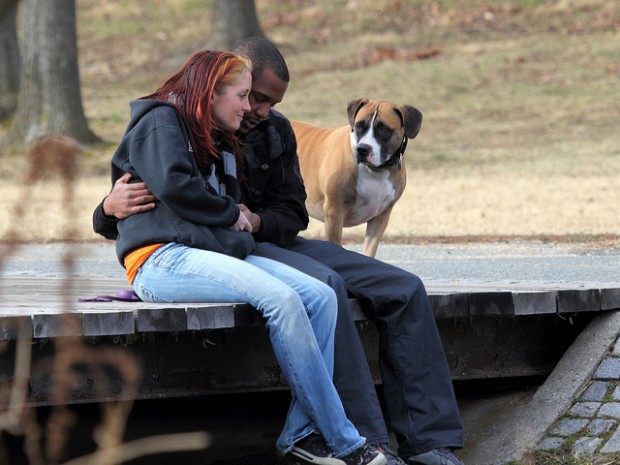From the photo stream of Mr. T in DC:

Mr. T in DC / Flickr
The Internet's hottest new site is ARGO DEMO. Blogger Matt Thompson is back, and he's better than ever. Hit us up daily for the latest in screencasts, how-tos, navel-gazery, blog criticism, MSM-bashing, and Nick Denton fanchatter.
From the photo stream of Mr. T in DC:

Mr. T in DC / Flickr
Fredrick Kunkle’s story in yesterday’s Washington Post on the battle over school choice in Virginia underscores the emotion in the debate. In Kunkle’s telling, the battle pits civil rights heroes, still yearning for equality, against ambitious young students, questing for opportunity:
On one side are black elders who remember when school choice meant no choice at all because of state-mandated segregation. Many also remember how vouchers were given to white children to attend private academies during “massive resistance” in the late 1950s and early ’60s, when Virginia closed some public schools rather than desegregate as ordered under the Supreme Court’s decision in Brown v. the Board of Education. Opponents argue that school choice might resegregate the schools, this time by class and ability.
On the other side is a younger generation of single parents and working-class black families looking for any way out of the state’s most troubled schools in places such as Norfolk, Petersburg and the capital. Even if it’s difficult to rescue all schoolchildren, an effort should be made to save some, they say.
Read to the very bottom of the story for a fascinating tidbit in the conclusion.
In Slate, Daniel Sharfstein recounts the history of Orindatus Simon Bolivar Wall, a freed slave and DC resident whose children decided to pass for white:
By any measure, O.S.B. Wall soon became a hero of African-American history, the kind of man Black History Month was created to celebrate. But today he is forgotten. The story of his rise to prominence and fall into obscurity reveals one of the great hidden narratives of the American experience. While O.S.B. Wall spent a lifetime fighting for civil rights, his children grew up to become white people. [...]
Wall had no family to claim and remember him. He and his wife had five children who survived to adulthood. They attended Oberlin, took government positions, and became active in black Republican circles in Washington. Within a few years of their father’s death, however, they began to cut their ties to the black community and identify as white. By 1910, no one was left who wanted to keep the memory of O.S.B. Wall alive.
While Wall’s life tracks some of the central themes of black history, his children’s lives reveal one of its great hidden stories. From the colonial era onward, African-Americans were continually crossing the color line and establishing themselves as white people. It was a mass migration aided by American traditions of mobility, a national acceptance of self-fashioning, and the flux of life on the frontier. It is easy to forget how significant this mass migration was, because it was purposely kept a secret. But it touched millions of lives, simultaneously undermining and reinforcing the meaning of black and white.
Thought this was a fitting link for the last day of Black History Month. The burial site of O.S.B. Wall can be found in Arlington National Cemetery, where his gravestone proudly notes his service as a member of the first black regiment of Civil War volunteers.
Metro weekend shutdowns to affect Blue, Orange lines: “From the rail system’s 10 p.m. Friday closing through midnight Sunday, there will be no Orange Line service between Stadium-Armory and New Carrollton. Five stations will be closed: Minnesota Avenue, Deanwood, Cheverly, Landover and New Carrollton. The Blue Line will not operate between Stadium-Armory and Benning Road. The Benning Road Station will remain open.” (Washington Post)
Alexandria has highest AIDS rate in Northern Virginia: “Most people living with HIV and AIDS in Alexandria are African-American men, a group that the commission has been trying to target by reaching out to the faith community.” (WAMU)
DC high school closures “absolutely an option”: “D.C. Public Schools Interim Chancellor Kaya Henderson says the District is looking at closing some high schools before the 2012-2013 academic year.” (WAMU)
Local restaurants for local kids fundraiser: “On Thursday March, 3rd, 2011, portions of proceeds from some of the best farm-to-table restaurants in Washington, DC will go to the D.C. Farm to School Network.” (dcfarmtoschool.org)
A Mayor-for-Life flashback: “On Feb. 26, 1986, then-Mayor Marion Barry held a special meeting of more than 100 D.C. government employees, to announce a new list of ’10 or 15 words’ that would be in every press release issued by the D.C. government.” (Washington City Paper)
You’ve heard of the DREAM Act, the bill that would offer a path to legal residency to great students that arrived in the US illegally when they were children. You’ve probably heard of SB 1070, Arizona’s law making it a state crime for non-citizens to be without their registration documents. But you might not have heard about Secure Communities, even though it’s a centerpiece of the Obama administration’s immigration policy, and it’s igniting plenty of controversy here in DC. And now more details are leaking out about how DC Police Chief Cathy Lanier has tried to work with the program. Continue reading

GrayTransition2010.org
Recognize this image from Vince Gray's mayoral campaign? Prepare to see something like it on improvement projects all over DC.
DCist flags a notable executive order in this week’s DC Register:
According to Executive Order 2011-45, [...] you’ll be seeing a lot more of “One City” around these parts — like everywhere the D.C. government maintains a presence.
The branding has already begun: the city’s annual Summer Youth Employment Program is now officially called the “2011 Mayor Vincent C. Gray’s One City Summer Youth Employment Program.”
The commenters at DCist are already bringing the snark, as they do. “Aside from the race baiting connotations, and campaign use, it’s not a slogan for a city,” posts Stmove. “It’s embarassing, as if the best thing we can say about the District is that it’s one city. It sort of makes Baltimore’s ‘Charm City’ look totally non ironic in comparison.” Best comment: “Yet another example of the “Novus Ordo Secretum” as prophecied in The Morals and Dogma of the Ancient and Accept Scottish Rite of Freemasonry, the Book of Revelations, the Last Words of Dutch Schultz, and the Fun 4 Kidz placemat at the Expressway 83 Shoney’s near McAllen, TX.”
How about it, DCentrists? Any thoughts on the logo, soon to be on DC business cards, letterheads and signs near you?
Crime in the Metro system hit a 5-year high in 2010, according to a WMATA report released today. That’s the banner finding among many grim facts in the report, which you can read in its PowerPoint-y entirety here. Here are some of the other surprises:
I’m not sure whether I expected this figure to be higher or lower, but it was definitely interesting. Many of our discussions of Metro crime over the past several months have been about youth on the Metro, such as today’s story embedded at right from MyFoxDC. Last summer’s brawl at Gallery Place sparked several comment threads about race and crime on various sites online, such as DCist. What do you think? Did you find this figure surprising?
This statistic, from the WaPo story about the report, paints a very disturbing picture. An account from a WaPo story last April provides some more context:
Both contract drivers [charged with sexual assaults against customers] were hired after passing a background check, said Nikki Frenney, vice president of public affairs for MV Transportation, which oversees the 1,500 drivers in the MetroAccess system for Metro. MetroAccess provides about 7,700 trips a day for people with disabilities who are unable to use regular bus and rail service.
MyFoxDC noted this in their story on the report. Indeed, the WMATA report claims no homicides occurred in the Metro system in 2010, but what happened to the homicide at the Congress Heights Metro Station in May? MyFoxDC asked Councilmember Tommy Wells, who didn’t have an answer for why the homicide might be omitted. The station wasn’t able to get a comment from Metro officials.
Construction is underway on the massive new Marriott Marquis hotel next to the Convention Center. Several of the empty buildings around the hotel will give way to smaller Marriott properties. I took some snapshots to document the neighborhood as it looks today.
Nathan Rott shares the story of Eric Sheptock, a self-described “homeless homeless advocate”:
Being homeless has become Sheptock’s full-time occupation. It’s work that has provided him with purpose and a sense of community. But it’s also work that has perpetuated his homelessness and, in a way, glorified it.
Sheptock, 41, wouldn’t take a 9-to-5 job that compromised his advocacy efforts or the long hours he spends tending to his digital empire, he says. He wouldn’t move out of the downtown D.C. shelter where he has slept for the past two years if it would make him a less effective voice for change.
Almost since the concept’s beginning, reality shows have existed to exploit cultural conflict. Take a mix of strangers from a variety of backgrounds and throw them together for a few weeks, and you’re almost certain to spark some quality reality television.
This might be why DC, with its mix of classes and cultures, loomed large in 2010 as a reality TV destination. Yet the contrast between DC and the city portrayed in the reality shows couldn’t be sharper, as Mike Riggs aptly pointed out in a recent City Paper essay. Reality television celebrates luxury lifestyle products, conspicuous consumption, haute cuisine. DC has all of these things, to be sure, but they don’t define life here for most of us. So we’re curious, what do the culture clashes of DC reality shows reveal?
Here are our picks for the best culture clashes of the year in DC reality television. Add your picks (and your thoughts) in the comments. Continue reading
The NPR Argo Network is a collection of websites by NPR member stations committed to strengthening local journalism
Learn More...
Humanosphere reports on global health and the fight against poverty from KPLU in Seattle
The Empire Reports on city and state politics from WNYC in New York
The Informant reports on cops, courts and communities from KALW in Oakland
Multi-American reports on immigration and cultural fusion from KPCC in Southern California
On Campus reports on higher education from MPR in Minnesota
Ecotrope reports on nature and community from OPB in Oregon
The Key reports on local music from WXPN in Philadelphia
CommonHealth reports on health, medicine and healthcare reform from WBUR in Boston
Argo MindShift reports on technology and education from KQED in San Francisco
Home Post reports on the military from KPBS in San Diego